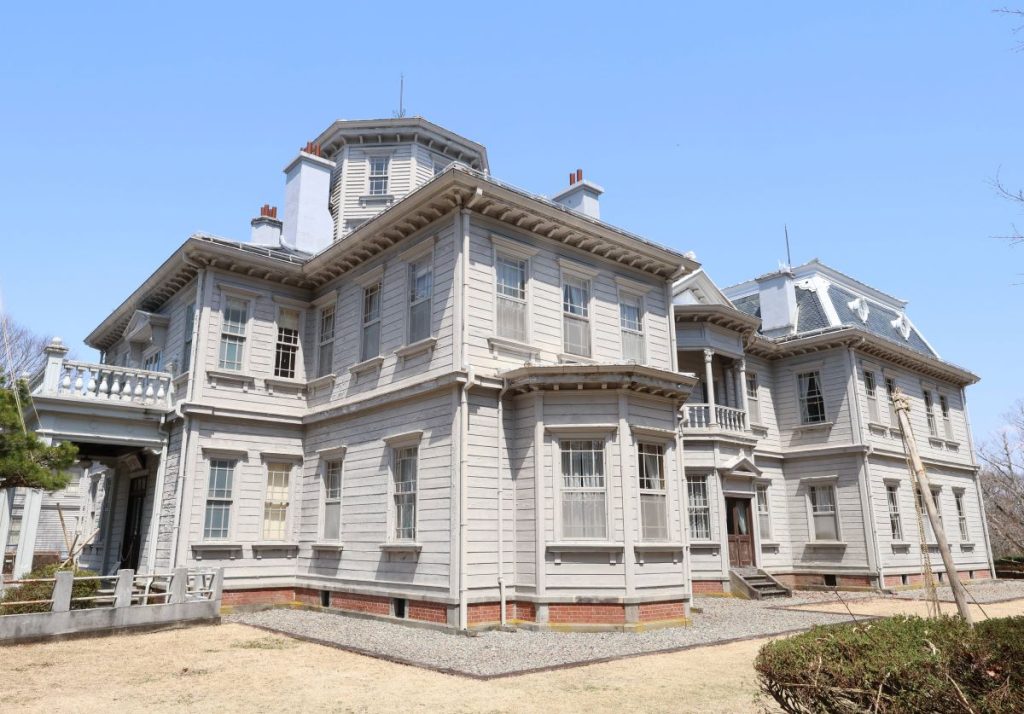
The elegant exterior of Tenkyokaku. Inawashiro Town, Fukushima Prefecture. (©Sankei by Nobuo Serizawa
このページを 日本語 で読む
Tenkyokaku sits on a hill overlooking the clear waters of Lake Inawashiro in Fukushima, Japan's fourth-largest lake. Built in 1908 as a villa for Prince Arisugawa Takehito, the Renaissance-style building is recognized as an Important Cultural Property of Japan. It has appeared in numerous films and television dramas, earning it a reputation as a "pilgrimage site" for fans.
A Meiji-Era Summer Villa
The name "Tenkyokaku" was given by Crown Prince Yoshihito, who later became Emperor Taisho. In 1952, the villa was gifted to Fukushima Prefecture and used for meetings and events.
However, due to aging infrastructure, it was closed in 1971. Restoration work began after its designation as an Important Cultural Property in 1979. The building's furniture and interior décor were carefully restored, and it reopened to the public in 1982. Today, it also features exhibits related to the imperial family.
Tenkyokaku welcomes about 25,000 visitors each year, with many coming from the Tokyo metropolitan area, as well as from Niigata and Miyagi prefectures. Its seasonal beauty — cherry blossoms in spring, autumn foliage, and snow in winter — makes it especially popular among photographers.

Protecting the Building's Legacy
Visitors first encounter the front gate, marked by brick pillars and stately iron double doors that lend a sense of grandeur. A short walk brings them to the Western-style villa, nestled among tall trees. The building's gray walls, with patches of peeling paint, hint at the harsh winters it has endured over the decades.
Tenkyokaku is made up of a main building and an annex. The main building is a two-story Renaissance-style structure with a total floor area of 492 square meters (5,296 square feet). Its distinctive features include an octagonal tower, a balcony above the entrance, and semi-circular dormer windows set into the sloped roof. Inside, visitors are drawn to the elegant chandeliers and luxurious carpets.
The building also houses 26 original fireplaces, each adorned with English-made Maiolica tiles. Because the imperial family never stayed there during the winter, the fireplaces were rarely used and remain in excellent condition.
Tenkyokaku is also a popular destination for fans of films and TV dramas. Notably, it appeared as the exterior of the orphanage in the 2020 live-action adaptation of The Promised Neverland (2020). Many visitors come to find and photograph the exact angles used in the film.


Step Into the Meiji Era
Guests can also experience dressing like Meiji-era nobles. Around 20 types of dresses are available, and staff are on hand to help with fitting. The costumes are worn over regular clothes and take about 5 to 10 minutes to put on. For a rental fee of ¥1,000 JPY (around $7 USD), visitors can enjoy wearing the outfits for 30 minutes inside the building (garden access is not included).
Two sisters in their 50s who tried on the costumes said they were pleasantly surprised by how easy the outfits were to wear and enjoyed taking photos.

The elder sister, visiting from Niigata, shared, "I felt immersed in the Meiji era. It was very romantic." Her younger sister from Nihonmatsu, Fukushima, added, "I'm glad I tried it. Even older visitors can enjoy this."
To help preserve the historic building, the use of tripods, reflectors, large photography equipment, and selfie sticks is not allowed.
Staff member Chiho Goto noted, "There are many highlights, from the intricate furnishings to the angel-themed chandeliers. We hope visitors will take time to reflect on the Meiji era through these details."
Acting director Sho Tabata added, "We want to preserve this important building and share its history, especially with younger generations."
Access
From Inawashiro Station, take a bus for about 9 minutes and get off at Nagahama Stop, then walk 10 minutes. By car, take the Ban'etsu Expressway to the Inawashiro Bandai-Kogen Interchange, then drive about 8 kilometers on National Route 49 toward Aizu-Wakamatsu.
Opening Hours are 8:30 AM – 5:00 PM (last entry at 4:30 PM) from May to October and 9:00 AM – 4:30 PM (last entry at 4:00 PM) from November to April.
RELATED:
- The 102-Year-Old Seawater Bathhouse Where Time Stands Still
- Rediscovering Japan's First Tourism Campaign at the Shibusawa Memorial Museum
- Hidden Wonders | Climb Like a Ninja at This Japanese Castle Playground
- New Exhibition Marks 120 Years Since Russo-Japanese War
Author: Nobuo Serizawa, The Sankei Shimbun
このページを 日本語 で読む








